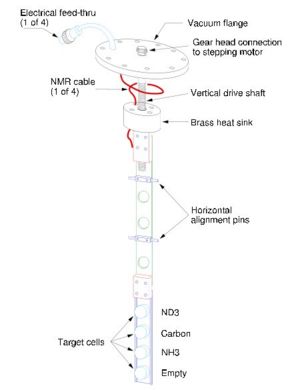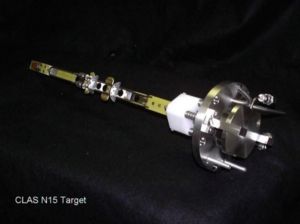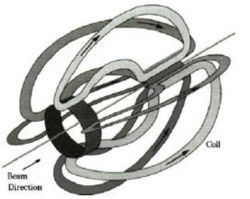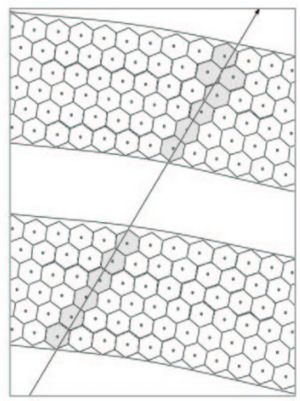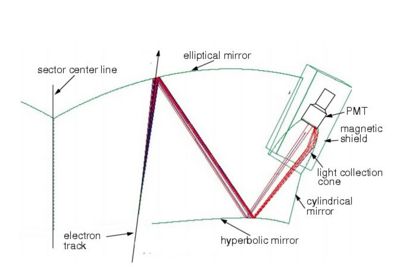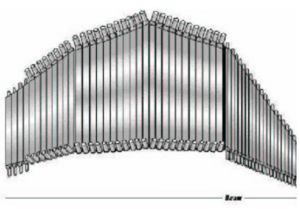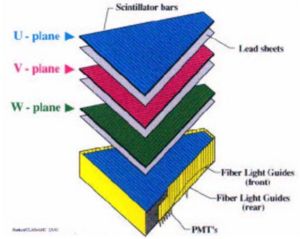CLAS apparatus
Apparatus
The EG1 experiment used the Continuous Electron Beam Accelerator Facility (CEBAF) for a source of polarized electrons, a polarized ammonia target, and the CEBAF Large Acceptance Spectrometer (CLAS).
Target
this first paragraph should introduce the topics of this section. It should include sentences about the polarized target magnet and NMR.
The EG1 experiment at Jefferson Lab used five different targets during their polarized structure function measurement program. The polarized and targets were designed and built by collaboration of the Italian Istituto di Fisica Nucleare, TJNAF, Oxford instruments and the University of Virginia. The solid targets( and ) were polarized using the method of Dynamic Nuclear Polarization[ insert reference]. A 5 Tesla magnet establish the yperfine splittings needed to polarize the target material using X Ghz RF waves. The polarization was monitored by pickup coils around the target using standard NMR techniques. Three other targets, , liquid and frozen were used to employ several methods for removing the Nitrogen contributions to the measured structure functions made using and .
Target Material
The target materials used during the EG1b experiment were frozen ammonia, for the polarized protons and for the polarized deuterons. Ammonia targets were selected because of their ability to produce high polarization and they are less effected by beam radiation. On the other hand, the damage caused by this radiation can be repair by annealing(heating process). In addition, ammonia target has a high ratio of free nucleons (~3/18) approximately 16.5 % for and 26.6 % for . One disadvantage of choosing ammonia is the polarization background caused by 15N(spin - 1/2), or 14N(spin - 1). However, for 15N the polarization can be measured easily then for 14N. Also, it does not have any free nucleons, while 14N has one free neutron. That concludes, in case of using 15N ammonia rather than 14N the spin asymmetry measurement should have a smaller correction and error.
The ammonia gas is frozen at 77 K, and then crushed into the spherical beads, about 1 - 3 mm in diameter, in order to provide good and uniform cooling with the liquid helium during the experiment.(?????????more needed)
The Magnet
The 5 T magnetic field parallel to the beam direction is produced by a superconducting pair of Helmholtz coils, which are cooled by the liquid helium reservoir located outside the CLAS detector. The uniformity of the field is varying less than over a cylindrical volume of 20 mm in diameter and length. This configuration is necessary for DNP. The particles with scattering angles between 0-50 are detected in the CLAS as well as 75-105 due to the 8 cm gap between the Helmholtz coils. The target magnetic field does not interact with the electron beam, however it is effective in shielding the drift chambers from the low energy Moller electrons.The target field bents the scattered particles in the azimuthal direction and it falls rapidly with distance as (). The effect of magnetic field at the drift chambers is negligible.
The Evaporation Refrigerator
The target is cooled to ~ 1 K using the helium, which is supplied from the 1 K evaporation refrigerator. Approximately 0.8 W cooling power is provided by a system of Roots and rotary-vane vacuum pumps that reach a pumping speed for helium gas of 3300 [reference !!!!!!!!].
The Target Inserts
The target insert was designed and built by the INFN of Genova. The target cells with a thickness of 0.2 mm were made out of polychlorotrifluoroethylene (PCTFE), it is a hydrogen-free material and would not produce an NMR background, also it is not effected by radiation as much as other materials. Each target cell is 15 mm in diameter and 10 mm in length sealed by a 0.025 mm thick aluminum foil at entrance window and 0.05 mm thick kapton foil at exit window. LHe in the target cells are supplied from the tiny holes which are located at the exit window and the ammonia beads.
The target insert has the four target cells. Two of them were filled with ammonia beads: the top one with and the other one with . was followed by carbon () disk with a thickness of 2.3 mm and the fourth cell was left empty. The carbon and the empty cells were used to measure background.
The Nuclear Magnetic Resonance(NMR) coils were wrapped around the outside surface of the cells in order to reduce the background, maximize the amount of ammonia in the target cells and monitor the polarization of the target. The geometry of the NMR coils were chosen so that they would be maximally sensitive to the target polarization. They were made out of CuNi material with a thickness of 0.15 mm and bent into rectangular loops. The temperature sensors(thermocouples, RuO resistors) were attached to the target insert at different locations to monitor the temperature of the target materials.
A second target insert was designed and built by the Jefferson Lab Polarized Target Group to measure the background using solid . The first measurements of electron scattering from target provided the data which was subtracted from the scattering data in order to eliminate the contribution of the . The insert cell is made out of a Torlon of 15.7 mm in diameter and 12.7 mm in length. Both sides of the cell are covered by kapton windows. The target cell was filled with isotopically enriched gas at room temperature and the insert was located into the target chamber in order to cool it by LHe, causing the gas to condense. To avert the target from freezing a heater wire was wrapped around the filling tubes and plugging the tubes before the cell was filled with the gas.
The target insert during the experiment is moved up or down using the stepping motor, which means that the target can be changed automatically.
The Microwave System
The ammonia beads were irradiated by the microwave field to polarize the target material, without reversing the magnetic filed.
Dynamic Nuclear Polarization
should read(ar dagaviwydes wyaros mititeba tamuna !)
Thermal Equilibrium polarization
A polarized target can be imagined as a number of particles with magnetic moment in a high magnetic field and cooled to low temperature. The Zeeman interaction between the atoms with magnetic moment and the external magnetic field B gives a set of 2I+1 sublevels, where the spin I=1/2 for proton and I=1 for deuteron. At thermal equilibrium the population of two magnetic sublevels at the T temperature is given by the Boltzmann Law[wyaro]:
- (1)
where is the Boltzmann constant and are the corresponding population numbers of the magnetic sublevels. The definition of the polarization for a system with spin-1/2 and spin-1 is following:[wyaro]:
- (2)
- (2)
The thermal equilibrium polarization is described by[wyaro]:
- (3)
- (3)
The nucleon polarization in this way is very small because of the small magnetic moment of the proton and deuteron. For example, in a 2.5 T magnetic field at 1 K temperature polarization for proton is 0.25 % and for deuteron 0.05 %. On the other hand, the magnetic moment of the electron is much higher, which gives a high polarization(92 % for the same conditions).
The Solid-State Effect
In the Solid State Effect of the Dynamic Nuclear Polarization a solid target material with a high concentration of polarizable nucleaons is doped with paramagnetic radicals which provide unpaired electron spins[wyaro_1]. As it was said above, the polarization of electron is high, due to its high magnetic moment value. After the electrons are polarized, the dipole-dipole interaction between the electron and nucleon spins provides the transformation of the polarization from electrons to the nucleons by irradiating the system with a frequency close to the frequency of the electron spin resonance.
?????????????????????????????????????????????///
There is only one parameter that can influence the Dynamic Nuclear Polarization, applied frequency. By changing the frequency one can change the direction of the nucleon polarization , it can be parallel or antiparallel to respect of the magnetic field.
The Nuclear Magnetic Resonance System
During the EG1b experiment the target polarization was monitored by a Nuclear Magnetic Resonance system. The princple of the NMR is to induce and detect nuclear magnetic transitions, where the transition rate is proportional to the population difference between the energy levels, showing the original polarization value. The macroscopic magnetization of the material is related to its polarization in the following way:
where V is a sample volume, N-number of spins, I - the spin value and - the magnetic moment of the individual spins.
Media:DGCrabbandWMeyerAnnRevNuclPartSci47671091997.pdf
The CEBAF Large Acceptance spectrometer
The CEBAF Large Acceptance spectrometer is a detector at Thomas Jefferson National Accelerator Facility which covers particle detection almost on 360 degree. The detector is divided into six sectors, each of them including a superconducting coil, which produce a toroidal magnetic field along the beam direction. As a charge particle tracking system was used a set of drift chambers divided by three regions, totally consisting of 18 drift chambers. After the drift chamber system the CLAS detector is equipted with Cherenkov counter for seperating electrons from the pions and with scintillators for determination of the Time of Flight of a charge particle. At the end of the detector the particle identification and timing(resolution) is achieved using electromagnetic calorimeters.
The Torus Magnet
The torus magnet for CLAS detector consists the six superconducting coils located around the beam line in a toroidal geometry, producing the magnetic field in the direction. Each magnetic coil defines the sector of detector. So the CLAS detector has six sectors(spectrometer). The system of the magnet is defined in spherical coordinates where the z-axis are along the beam direction and the x and y axis along the horizontal and vertical plane normal to the beam line.
The maximum current for the CLAS magnet is 2860 A, in the forward direction the total magnetic field is 2.5 T-m and at a polar scattering angle with 90 degrees 0.6 T. The magnet itself is around 5 m in diameter and 5 m in length. The coils of the magnet are cooled by liquid helium circulating through cooling tubes to a superconducting temperature of 4.5 K. The cooling tubes are placed at the edge of the windings The magnetic field form by the torus magnet bends charged particles toward or away from the beam direction depending of the charge of the particle and the polarization of the torus(inbending and outbending).</ref>Yelena Alexsandrovna Pork, Measurement of The spin Structure Functions of The Proton in The resonance Region<ref> One can find out the charged particles momentum knowing the trajectory of a particle. In Eg1b experiment, the operated torus values were: 2250, -2250, 1500, -1500.
Drift Chambers
In order to track the charged particles in the EG1b experiment a drift chamber system is used. A drift chamber is a particle tracking detector that measures the drift time of ionization electrons in a gas to calculate the spacial position of an ionizing particle.
{theory about drift time?????/}
The drift chamber system in CLAS detector is divided into three regions, each consisting six separate chambers(six sectors). Region 1 (R1) chambers are placed closest to the target, where the magnetic filed is low. Region 2 (R2) chambers are in a high magnetic field region, they are located between the magnetic coils. Region 3 (R3) chambers are outside the torus coils and they are largest ones. The drift chambers contain three type of wires stretched between the endplates: sense, guard and field. The endplates are attached to the drift chamber so that the angle the form is equal to 60 degrees. Each drift chamber is subdivided into two separate superlayers. Each superlayer with six layers of drift cells, and each drift cell with one sense wire surrounded by six field wires forming a hexagonal shape(///////tamuna aq surati unda axseno, ar dagaviwydes///). Each superlayer is surrounded by guard wires at a positive potential to stimulate the electric field caused by the drift cells. The sense wire is operated at positive potential and the field wire at negative. In each superlayer the distance between the sense and field wire increases with the radial distance from the target. In R1 the average distance between the sense and field is 0.7 cm, in R2 1.15 cm and in R3 2.0 cm.
The gas used to fill the CLAS drift chamber is a 90 - 10 % mixture of the argon(Ar) and , where Ar has an ionization gain of . Inside the drift chamber the constant pressure is provided by outflowing the gas. The chamber endplates are equipped with the circuit board with a single channel differential pre-amplifier for each sense wire.
Cherenkov detector
The threshold CLAS Cherenkov detector is used to distinguish electrons from pions. The mixture gas used to fill the Cherenkov counter is perfluorobutane gas at atmospheric pressure. The advantage of Perfluorobutane gas is its high index of refraction n=1.00153, which results in a high photon yield and the following energy thresholds. The threshold for the Cerenkov radiation can be written as , or for energies , where v is the velocity of charged particle, n index of refraction for the medium, c speed of light and . In our case , accordingly one can calculate the energy threshold for different charged particles, for electrons it is 9 MeV and for pions 2.5 GeV.
The six superconducting coils placed at angles of 60 degrees in the azimuthal angle around the electron beam line produce a 5 T magnetic field.It is important to minimize the amount of material in all of the detectors to minimize hadron and electron absorption and secondary particle production upstream of the time-of-flight scintillators and calorimeters. The detector was divided in the six sectors with each sector independently instrumented to be an effective spectrometer. The Cherenkov detector was designed to maximize the coverage in each of the sectors up to an angle degrees.
As a light collector were used the system of mirrors , the light collecting cones and photomultiplier tubes(PMTs). In the extreme regions of the angular acceptance of the spectrometer the number of detected photoelectrons is too low. To get acceptable efficiency of the detector in these regions were placed photomultiplier tubes.
The charged particle trajectories are in planes of almost constant azimuthal angle, because of the toroidal configuration of the magnetic field. Under this conditions, the light collection can be designed to focus the light in the azimuthal angle direction. However, the polar angle is constant. Each of the six sectors was divided into 18 regions of the polar angle and each segment was bisected into two modules by the symmetry plane. This results in a total of 12 identical subsectors around the azimuthal direction for each the polar angle interval and a total of 216 light collection modules.
The optical elements of each module were two focusing mirrors one elliptical and the other one hyperbolic, a "Winston" light collection cone and a cylindrical mirror at the base of the cone to improve the focusing. The light was detected by means of 5 in. Phillips XP4500B PMT placed at the base of the Winston cone.
The calibration of the Cherenkov detector is in terms of the collected number of photoelectrons.
Scintillators
The CEBAF Large Acceptance Spectrometer (CLAS) is equipped with 288 scintillator counters. The purpose of the scintillator is to determine the time of flight for the charged particles and to trigger it in coincidence with another detector system for the particle identification. The time of flight system is built so that time resolution at small polar angles ps and at angles above 90 degrees ps. This time resolution helps to discriminate pions and kaons up to 2 GeV/c.
The time of flight system is located between the Cherenkov detectors and electromagnetic calorimeters. The scintillator strips(BC_408) are located perpendicularly to the average particle trajectory with an angular polar coverage of 1.5 degrees. Each sector of The CLAS detector consists of 48 scintillator strips with a thickness of 5.08 cm. The length of the scintillators varies from 30 cm to 450 cm and the width is between 15 cm at small polar angles and 22 cm for the large angles.
Each scintillator of the CLAS detector is surrounded with a photomultiplier tube. When particle hits the scintillator strip, part of its energy can excite atoms in the scintillator which in the end produces light(visible). The produced light is transmitted to the photomultiplier tubes by light guides.
For each photomultiplier tube the time and pulse height are measured. This is important to evaluate the time-walk correction and in addition, the measure of the pulse height gives information on the energy released by the crossing particle.
Calorimeter
The CLAS detectur contains 8 modules of electromagnetic calorimeter. A calorimeter is a device that measures the total energy deposited by a crossing particle. They are useful in detecting neutral particles and distinguishing between electrons and hadrons due to their different mechanism of depositing energy. The CLAS calorimeter has three main functions:
1) detection of electrons at energies above 0.5 GeV;
2) detection of photons with energies higher than 0.2 GeV;
3) detection of neutrons, with discrimination between photon and neutrons using time-of-flight technique.
6 calorimeter modules of the CLAS detector are placed in each sector in the forward region (polar angle of 10-45 degrees, forward angle calorimeter), while the other two modules are located at large angles in sectors 1 and 2(50-70 degrees, large angle calorimeter). The forward calorimeter has a lead/scintillator thickness ratio 0.2, with 40 cm of scintillators and 8 cm of lead per module. The lead-scintillator sandwich is shaped as a equlaterial triangle in order to match the hexagonal geometry of the CLAS detector. It is made of 39 layers of a 10 mm BC_412 scintillator and lead sheet of thickness of 2.2 mm. Each scintillator layer contains 36 strips parallel to one side of the triangle, with this configuration each orientation is rotated by 120 degrees from another one. This gives three views each containing 13 layers providing stereo information of the location of the energy deposition.
To improve hadron identification, there was provided longitudinal sampling of the shower. Each set of 13 layers were subdivided into an inner 5 layers and outer 8 layers stack.
